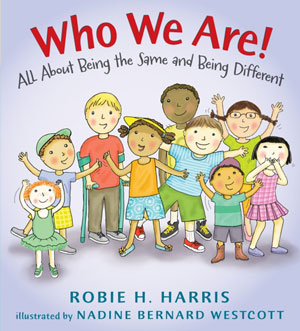Candlewick Press, March 2016
Illustrated by Nadine Bernard Westcott
Young children think about and have endless questions about “who they are” and “who all the other the people in their lives are.” They think about making friends; how they wish to be treated by others; how others wish to be treated by them. It’s a time when they can learn how to treat others who may be different from them with respect. I wrote WHO WE ARE! All About Being the Same and Being Different as a way to have a conversation with young children about diversity—about the world in which most young children live. Join Nellie, Gus, baby Jake and their parents at Funland as they go on rides, watch a performer, and play games with many other kids and adults who portray what our nation and the world really looks like. My hope is that their story can help children embrace the diversity that is part of their everyday lives.
K-Gr 2–Presenting several diverse families enjoying the various attractions at an amusement park, Harris explores the numerous ways that people are alike and different. Many examples are presented; for instance, while we all have many of the same body parts, those parts come in different shapes and sizes. The author provides an explanation of some of the causes of similarities and differences, such as genetics. Her concluding message is that no matter how different we may be, we all have feelings and that it is wrong to use differences put people down. Westcott’s signature child-friendly cartoon illustrations support and expand the theme of the text. Crisp and clear, the images depict a variety of individuals—children in wheelchairs, a woman in a hijab, a man wearing a turban, and a boy wearing a yarmulke—and add charm and invite repeated examination. VERDICT A valuable addition to most collections and particularly useful as a springboard to antibullying discussions.–Grace Oliff, Ann Blanche Smith School, Hillsdale, NJ
This title continues Harris and Westcott’s Let’s Talk about You and Me series of books, which makes abstract concepts accessible to young readers and their adults. Their newest follows an interracial family through an amusement park—where better to find a kaleidoscope of humans? Siblings Nellie and Gus notice how they look “a little bit alike. But not a lot alike.” From there, the lens expands to all the people around them. Difference is explained first in simple terms, such as clothes, haircuts, and so forth, moving to more complex ways, like hair texture and eye shape. These details set the stage for an explication of the roles of melanin and inheritance and, later, for the reality of how difference can be scary or make people say mean things. Every unkind act can be remedied, however, and ultimately, we’re all more the same than we are different. — Amina Chaudhri
